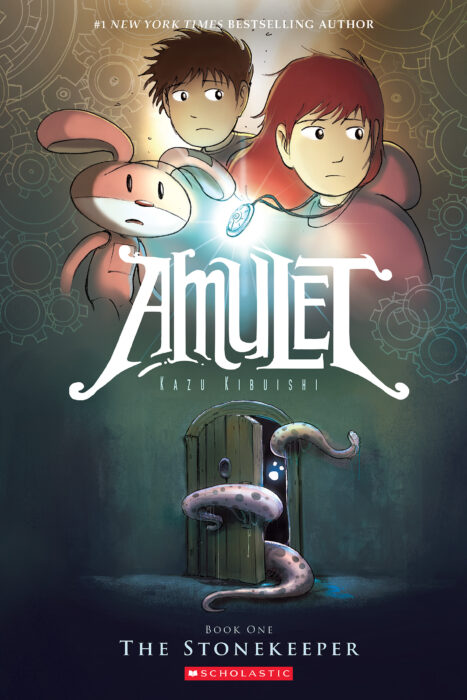The Amulet: The Stonekeeper by Kazu Kibuishi
Kibuihi, K. (2008). The amulet: the stonekeeper. (K. Kibuishi, Illus.) Graphix.
The
Stonekeeper is the first book in The Amulet series, a magical fantasy series that
revolves around family. From learning about ancestors to rescuing family
members, the theme of family stays at the forefront of the story with a number of
relationships the reader can relate to. This allows the story to stay grounded
even with the crazy fantastical elements that are constantly present. To assist
in portraying the unique qualities of the created world, the color scheme is unorthodox
but pleasant rather than distracting. A mix of warm and cool colors like blues,
purples, oranges, and browns fills each page. The illustrations also help keep up
the forward momentum; there are many panels drawn with action lines which lets
the readers eyes glide across the page with ease, making this a quick and fun
read.
Though it begins pretty somberly
with a car crash resulting in the death of the father, the action is present
immediately and never strays too far. The illustrations enhance this constant
movement by using different panels in a row as snapshots of the action like a
movie jump cutting from character to character in an intense scene. This is
evident immediately in the opening scene. After the car crash, as the
protagonist and her mother try to save the father, each panel focuses on a
single character to display each of their different actions and reactions while
the car slowly tips off the edge of the cliff with the father still inside. By
focusing on one character at a time, the illustrations provide an emotional
aspect to the scene while ramping up the intensity. The book doesn’t exactly
get happier as it goes on, but there is an air of hope to it as the protagonist
receives her power and begins to save lives.
On a level of understanding, the
plot is a bit convoluted, introducing a lot in a short period of time. It may
start off as a little tricky depending on the age of the reader, but the details
are not completely imperative to understand the magical power and where the
good vs. evil line is drawn. As with many fantasy books, the introduction is
always the hardest because it must do the job of creating an explaining a whole
new world with different rules and outcomes that sometimes take a while to
grasp. The more the reader delves into this world, going through this book and
the rest of the series, the easier it will be for them to understand the
different dynamics and laws. It may, however, be difficult to supply the other
books to the reader because the series is long with nine books. This may be
unsatisfying as well because this first book leaves off with a cliffhanger and
most likely the others include one as well.
The
Stonekeeper is the first book in The Amulet series, a magical fantasy series that
revolves around family. From learning about ancestors to rescuing family
members, the theme of family stays at the forefront of the story with a number of
relationships the reader can relate to. This allows the story to stay grounded
even with the crazy fantastical elements that are constantly present. To assist
in portraying the unique qualities of the created world, the color scheme is unorthodox
but pleasant rather than distracting. A mix of warm and cool colors like blues,
purples, oranges, and browns fills each page. The illustrations also help keep up
the forward momentum; there are many panels drawn with action lines which lets
the readers eyes glide across the page with ease, making this a quick and fun
read.
Though it begins pretty somberly
with a car crash resulting in the death of the father, the action is present
immediately and never strays too far. The illustrations enhance this constant
movement by using different panels in a row as snapshots of the action like a
movie jump cutting from character to character in an intense scene. This is
evident immediately in the opening scene. After the car crash, as the
protagonist and her mother try to save the father, each panel focuses on a
single character to display each of their different actions and reactions while
the car slowly tips off the edge of the cliff with the father still inside. By
focusing on one character at a time, the illustrations provide an emotional
aspect to the scene while ramping up the intensity. The book doesn’t exactly
get happier as it goes on, but there is an air of hope to it as the protagonist
receives her power and begins to save lives.
On a level of understanding, the
plot is a bit convoluted, introducing a lot in a short period of time. It may
start off as a little tricky depending on the age of the reader, but the details
are not completely imperative to understand the magical power and where the
good vs. evil line is drawn. As with many fantasy books, the introduction is
always the hardest because it must do the job of creating an explaining a whole
new world with different rules and outcomes that sometimes take a while to
grasp. The more the reader delves into this world, going through this book and
the rest of the series, the easier it will be for them to understand the
different dynamics and laws. It may, however, be difficult to supply the other
books to the reader because the series is long with nine books. This may be
unsatisfying as well because this first book leaves off with a cliffhanger and
most likely the others include one as well.

Comments
Post a Comment